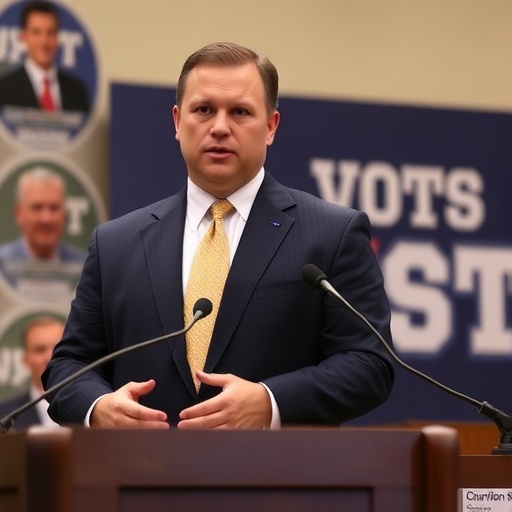Doug Mastriano Mulls Pennsylvania Governor Run with GOP Criticism as Stacy Garrity Accelerates Campaign Against Shapiro
In a twist that could reshape Pennsylvania’s political landscape, Doug Mastriano, the 2022 Republican nominee for governor, is seriously considering another bid for the state’s top office while unleashing pointed criticisms against the GOP establishment. This development comes as State Treasurer Stacy Garrity ramps up her own campaign to challenge incumbent Democratic Governor Josh Shapiro, who remains coy about his re-election intentions ahead of the 2026 race.
- Mastriano’s Fiery Critique Targets GOP ‘Elites’ and Past Failures
- Stacy Garrity’s Campaign Gains Steam with Focus on Fiscal Conservatism
- Shapiro’s Re-Election Enigma Looms Over Pennsylvania’s 2026 Landscape
- Potential GOP Primary Clash: Mastriano vs. Garrity Dynamics Unfold
- Implications for Pennsylvania’s Future: Economic and Policy Battles Ahead
Mastriano‘s potential re-entry into the gubernatorial fray has sent ripples through Pennsylvania’s Republican circles, especially as Garrity, a rising star in the party, intensifies her efforts to position herself as the frontrunner. With Shapiro’s approval ratings hovering around 55% according to a recent Franklin & Marshall College poll, the GOP sees an opening but faces internal divisions that Mastriano’s words have only amplified.
Mastriano’s Fiery Critique Targets GOP ‘Elites’ and Past Failures
Doug Mastriano, a retired Army colonel and state senator from Franklin County, didn’t mince words during a recent interview on a conservative podcast, where he lambasted the Republican Party for what he called a “betrayal of core values.” Speaking directly to his base, Mastriano accused GOP leaders of abandoning the grassroots supporters who propelled his near-upset in the 2022 election. “The party elites in Harrisburg and Washington have sold out to the moderates and the donors, leaving real Pennsylvanians behind,” Mastriano stated, his voice rising with frustration. This rhetoric echoes his 2022 campaign, which emphasized election integrity, Second Amendment rights, and opposition to COVID-19 mandates—issues that resonated with Trump’s MAGA wing but alienated some traditional Republicans.
Mastriano’s criticisms aren’t new; they stem from his contentious 2022 primary victory over establishment favorites like Scott Wagner and Lou Barletta. Despite raising over $10 million through small-dollar donations, his general election loss to Shapiro by 15 points (56% to 41%) was attributed by some to his reluctance to debate and limited media engagement. Yet, Mastriano remains unapologetic. In a statement to reporters last week, he said, “The GOP needs to remember why we fight: for freedom, for families, and against the radical left. If they won’t lead, I will consider stepping up again for Pennsylvania.”
Political analysts see this as Mastriano positioning himself for a comeback. “Mastriano’s base is still loyal; he pulled in 1.2 million votes last time, more than any Republican gubernatorial candidate in recent memory outside of Trump-aligned races,” noted Dr. Christopher Borick, director of the Muhlenberg College Institute of Public Opinion. However, Mastriano’s favorability ratings sit at just 35% statewide, per a June 2024 Emerson College poll, which could hinder his broader appeal in a state where Democrats hold a voter registration edge of 400,000.
The senator’s barbs have drawn swift responses from GOP insiders. State party chair Lawrence Tabas dismissed them as “sour grapes,” emphasizing the need for unity. “We’re focused on winning in 2026, not rehashing 2022,” Tabas told Pennsylvania Capitol News. Still, Mastriano’s words highlight deepening fissures within the Pennsylvania GOP, a party that controls the state House but struggles with internal unity post-Trump.
Stacy Garrity’s Campaign Gains Steam with Focus on Fiscal Conservatism
As Mastriano mulls his options, State Treasurer Stacy Garrity is leaving little to chance in her bid to become Pennsylvania’s next governor. Garrity, a former businesswoman and Army veteran from Blair County, officially launched her exploratory committee in early 2024 and has since crisscrossed the state, raising over $2.5 million in the first quarter alone—outpacing early fundraising from other potential contenders. Her campaign slogan, “Secure Pennsylvania’s Future,” underscores her emphasis on economic stewardship, border security, and education reform, themes tailored to appeal to suburban voters in the Philadelphia and Pittsburgh collar counties.
Garrity’s tenure as treasurer since 2021 has been a boon for her profile. Under her watch, the office invested $1.2 billion in Pennsylvania-based businesses through the state’s Unclaimed Property program, returning funds to over 100,000 residents. “As treasurer, I’ve proven I can manage billions responsibly—now it’s time to apply that to the governor’s office,” Garrity declared at a rally in Harrisburg last month, where she drew a crowd of 500 supporters waving signs emblazoned with her name. Her military background, including service in Iraq, adds a layer of credibility on national security issues, especially as she ties Pennsylvania’s economic woes to federal immigration policies.
Unlike Mastriano’s insurgent style, Garrity is courting establishment donors. She’s secured endorsements from key figures like former U.S. Rep. Bill Shuster and has appeared at events hosted by the Pennsylvania Manufacturers’ Association. A recent Siena College Research Institute survey shows her with 28% support among likely Republican primary voters, edging out Mastriano’s 25%. “Garrity represents the pragmatic conservative the party needs to flip the governorship,” said GOP strategist Chris Kelly, who advised past statewide campaigns.
Yet, Garrity faces challenges. Critics point to her limited legislative experience and question whether she can unify the party’s factions. In a pointed exchange during a June debate forum, she responded to Mastriano’s criticisms by saying, “Doug talks a big game, but results matter. I’ve delivered for taxpayers every day— that’s what Pennsylvania needs from its governor.” Her campaign’s digital ads, which have garnered 1.5 million views on YouTube, highlight these contrasts, portraying her as the steady hand against Shapiro’s “tax-and-spend” policies.
Shapiro’s Re-Election Enigma Looms Over Pennsylvania’s 2026 Landscape
Governor Josh Shapiro’s silence on his 2026 plans has created a vacuum that’s both opportunity and uncertainty for Republicans like Mastriano and Garrity. Elected in 2022 with a decisive margin, Shapiro has notched wins on education funding—increasing K-12 budgets by $1.1 billion—and infrastructure, securing $1.7 billion from the federal Bipartisan Infrastructure Law for Pennsylvania roads and bridges. His administration also navigated a budget surplus of $14 billion in 2023, though critics argue it’s eroding amid rising costs.
Shapiro’s national profile has surged, with speculation tying him to Vice President Kamala Harris’s short-lived 2024 presidential ticket. A Politico report from August 2024 noted his vetting for VP, boosting his fundraising hauls to $25 million for Democratic committees. Yet, in Pennsylvania, his approval dips to 48% among independents on issues like crime and the opioid crisis, per a July 2024 Quinnipiac University poll. Shapiro has teased his intentions, telling reporters at a Pittsburgh town hall, “I’m focused on delivering for Pennsylvanians every day— the future will take care of itself.”
If Shapiro runs, the race becomes a heavyweight bout in this battleground state, which delivered narrow wins for Biden in 2020 and Trump in 2016. Pennsylvania’s 19 electoral votes make it pivotal, and a GOP gubernatorial victory could signal shifts ahead of 2028. Democrats, holding a 500,000-voter edge, rely on Shapiro’s crossover appeal; he won 2022 with 20% of the Black vote and strong suburban support.
Meanwhile, potential Democratic challengers like state Attorney General Michelle Henry or U.S. Rep. Madeleine Dean are watching closely. Shapiro’s team has already aired preemptive ads touting his record, spending $500,000 in media buys across Philly and Pittsburgh markets.
Potential GOP Primary Clash: Mastriano vs. Garrity Dynamics Unfold
The brewing tension between Mastriano and Garrity could define the Republican primary, set for May 2026. Mastriano’s potential entry would split the Trumpist and moderate wings, reminiscent of the 2022 primary where he won with 45% of the vote amid a crowded field. Garrity, polling strongly in southeastern Pennsylvania, aims to consolidate establishment support, targeting delegates at the state convention in July 2025.
Fundraising will be key: The 2022 cycle saw $100 million spent statewide, with Republicans outspent 2-to-1. Garrity’s early war chest gives her an edge, but Mastriano’s grassroots network—bolstered by 50,000 email subscribers—could mobilize quickly. “This primary will test whether the GOP learns from 2022 or repeats the chaos,” predicted G. Terry Madonna, a longtime Pennsylvania pollster.
Other names, like U.S. Rep. Dan Meuser or Senate President Pro Tempore Kim Ward, may jump in, complicating the field. Ward, a Mastriano critic, has hinted at her interest, saying, “Pennsylvania deserves bold leadership, not division.” A multi-candidate scrum could benefit Democrats, who unified behind Shapiro early.
Polling data underscores the stakes: A hypothetical matchup shows Shapiro leading Garrity 52%-44% and Mastriano 55%-40%, according to an internal GOP memo leaked to The Inquirer. Voter turnout, critical in primaries (often under 20%), will hinge on enthusiasm—higher for Mastriano’s base but broader for Garrity’s pitch.
Implications for Pennsylvania’s Future: Economic and Policy Battles Ahead
Whoever emerges as the GOP nominee will face a Shapiro-led state grappling with $45 billion in unfunded pension liabilities and a manufacturing sector employing 600,000 but losing ground to automation. Mastriano advocates slashing regulations and expanding fracking in the Marcellus Shale, which produced $5 billion in taxes last year. Garrity echoes this but adds fiscal tweaks, like auditing state spending for waste—echoing her treasurer role where she uncovered $200 million in improper payments.
Shapiro’s agenda includes universal pre-K and green energy investments, drawing $800 million in federal grants for solar projects. A GOP win could pivot toward tax cuts; Pennsylvania’s flat 3.07% income tax burdens working families, per the Institute on Taxation and Economic Policy.
Looking ahead, the race will influence U.S. Senate contests in 2026, where Democrat John Fetterman defends his seat. National Republicans, eyeing Pennsylvania’s swing status, have funneled $10 million into state PACs already. As Mastriano weighs his decision—expected by year’s end—and Garrity builds momentum, the Keystone State’s political drama promises to captivate the nation, testing the GOP’s ability to unite for a governorship that controls a $50 billion budget and 13 million residents.
With endorsements trickling in and debates on the horizon, Pennsylvania voters brace for a contest that could redefine the commonwealth’s trajectory through 2030.








